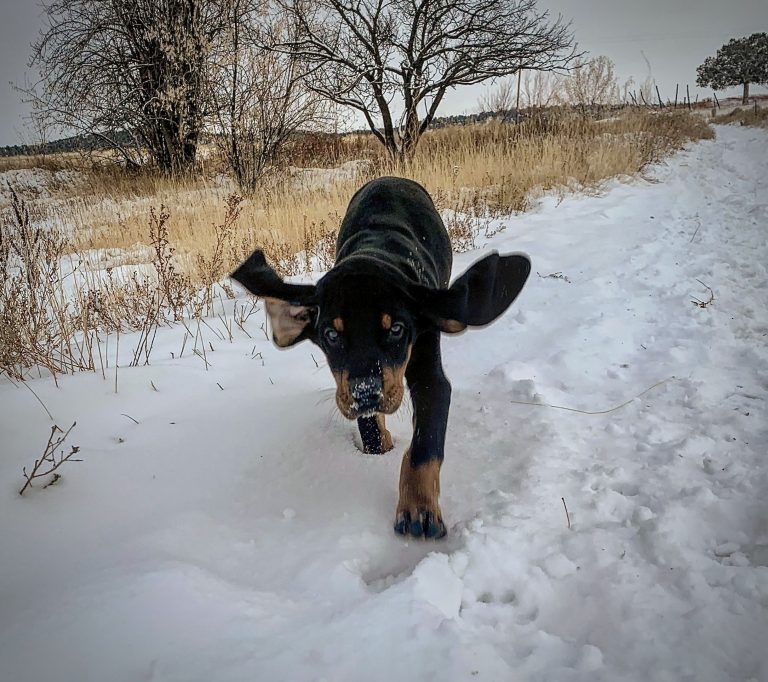You show up to the kennel and have high hopes to pick out your next hunting companion and as soon as the door is opened, your hit face first with a dozen gnashing, razor toothed, long eared, hound pups. In the first couple minutes, each one looks the same, acts the same, and you can’t begin to think how you would differentiate between personalities at the ripe age of eight weeks. So, what are you looking for? Personally, I want a companion that can be the stereotypical porch hound in the summer; laid back, not a care in the world, yet flip a switch when he hears the D loops jingle on his training collar and the engine to the truck kick-on in the dark following a fresh snow. I want a pup that thinks about hunting as much as I do but isn’t the wired, trials type of personality. It can feel a bit like a lottery standing over that whelping box, yet, there are a few steps I have picked up through a long family history of training and raising hunting dogs in order to stack the odds.
Who's Mom and Dad
This may seem overall obvious in the hound world as pedigree is talked about in lore about as much as the southern Arizona Jaguar. Lineage, simply put, who is the sir and bitch to throw the litter. How do they hunt? Do they tend to drill down on a track or run out front nose up when the race is jumped? How’s their temperament, scared of their shadow or do they eat holes through the chain link to get after the barn cat strolling by? I don’t want my words to be misconstrued that every pup will become their parents mirrored image, but I would say you can begin stacking your chips if the parents are proven hunters. In the end, dogs are a bit like kids, they each have their own personality, yet if you watch close enough, you can pick up the ticks carried through genetics. The deeper and more consistent of a pedigree, the higher percentage odds the pups will carry these genetic traits. If you can draw back into your memory bank from freshman biology, the recessive traits will be bred out of the line over time while the dominant qualities will be reinforced.
Who’s the lover and who’s the fighter
Now we are talking a little more opinion. Personality may be difficult to pick out at a puppies age, but generally you can see the outliers; whose chewing your pant leg and whose happier hanging out in the corner of the box? Personally, I have chosen dogs that fit both descriptions and ultimately been satisfied with each decision. For the purpose of an anecdote, I’ll share the story of Kimber and Josie. Kimber would tear the drywall out of the house if a mouse scratched the floor boards while Josie insists on sitting at our daughter’s feet during story time before bed. In choosing Kimber, I wanted a spit fire. She was draggin’ the other pups in the kennel around by their ears and singing to the sky the entire ride home. Josie, on the other hand, let me handle her, turning her upside down and spinning her whiskers the day she came home. In the end I like a little variety, just know what you’re looking for and likely you can pick up nuances within their personality even as a rolling ball of fur in the kennel.
How Healthy
While I love a pup with a personality, I want one that is coming home healthy. Some of these issues are taken care of with the first decision point of pedigree; hip dysplasia, foot malformations, genetic heart defects to name a few. Though, it is a good idea to get the pup out of the box and walk around for a bit. Let them follow you along and watch their gate. Do they instinctively follow along behind without trouble? Most immediate physical issues are relatively easy to pick up through a quick assessment of the pup separated from the rest of the group. Lastly, be sure the breeder has kept up with their shots; typically, this means a first round of DPV at 6 or so weeks old.
What matters most?
I will leave you with this, aside from the health of your pup, there is not a wrong decision. This is one day in the lifetime of your relationship together. Traits can be removed and accentuated through consistent training and nurturing. That Kimber dog I mentioned earlier, has learned to lay on the floor, quiet and calm until it’s time to go. Meanwhile Josie will still bay treed just as hard as the others. These dogs become a sum of their blood, our time, and their experience.







